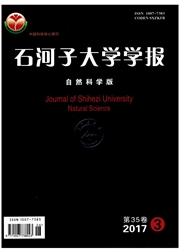

 中文摘要:
中文摘要:
采用等体积浸渍法制备了1%AuCl3/AC催化剂,探究了硫化氢(H2S)为毒物对乙炔氢氯化反应中催化剂催化活性的影响及失活机理。催化活性测试结果表明,以H2S为毒物可导致乙炔氢氯化反应中的AuCl3/AC催化剂的失活,且是一个不可逆过程;程序升温还原(TPR)和X射线光电子能谱(XPS)分析结果表明,H2S的加入可有效地加快Au^3+还原为Au^0;透射电镜能谱(TEM-EDX)观测分析形成的Au-S化合物也可导致催化剂失活,即随着H2S量的增大,更多的Au^3+被还原为Au^0,且形成的Au-S化合物覆盖在活性位点,使有效的活性组分降低进而导致AuCl3/AC催化剂失活。
 英文摘要:
英文摘要:
A study about poisoning effect of hydrogen sulfide (H2S) on the catalytic performance of AuCl3/AC during acetylene hydrochlorination deactivation is described and discussed. 1% AuCl3/AC catalyst is prepared by an incipient wetness impregnation technique. The activity tests demonstrate that H2S poisoning results in the rapid and irreversible deactivation of AuCl3/AC catalyst in acetylene hydrochlorination. Temperature-programmed reduction (TPR) and X-ray photoelectron spectra (XPS) show that H2S addition can effectively accelerate active Au^3+ reduction to metallic Au^0. The formation of metal sulfide may also be another reason for catalyst deactivation in the presence of H2S, which is supported by transmission electron microscopy (TEM) and energy dispersion X-ray spectrometer (EDX) techniques. In other words, with the increase of H2S added to the feed gases, the content of Au^3+ is greatly reduced to metallic Au^0. Moreover, the active sites are covered with Au-S compound. Both of them could reduce the effective active component, leading to the deactivation of the AuCl3/AC catalyst.
 同期刊论文项目
同期刊论文项目
 同项目期刊论文
同项目期刊论文
 期刊信息
期刊信息
